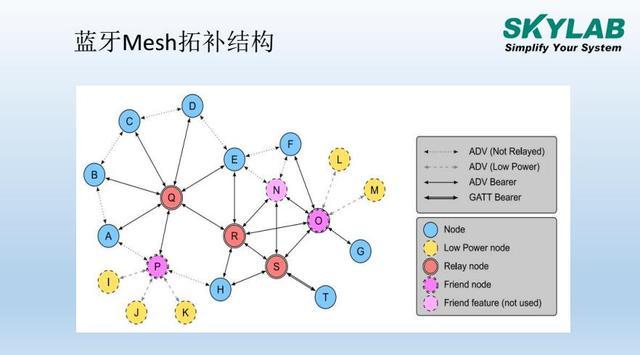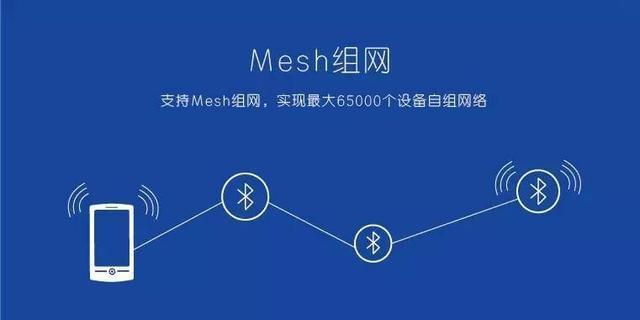Engineers who have been exposed to Bluetooth Mesh technology are aware that Bluetooth Mesh technology has the advantages of openness, low cost, high performance, etc., which can make up for the embarrassing situation that low-power Bluetooth cannot be networked in practical applications, and support for Mesh network. Low-power Bluetooth technology has entered a wider range of applications, enhancing its suitability for building automation applications.

With Bluetooth Mesh, we are able to create large networks and support secure, reliable communication between thousands of devices. The Bluetooth Mesh network includes Node, Element, Model, and State. In this article, SKYLAB will introduce the nodes of the Bluetooth Mesh in detail, and the Node is already activated. Become a member of the Mesh network.
The Bluetooth Mesh specification describes four "nodes" in detail, namely "relay node", "low power node", "friend node" and "proxy node".
Relay node: The ability to receive and resend mesh messages through the broadcast bearer layer to build a larger network.
Proxy node: The ability to receive and resend mesh messages between the GATT and the broadcast bearer layer.
Low-Power node: Ability to operate in a mesh network with significantly lower receiver duty cycles. The node power consumption is reduced by minimizing the radio receiver enable time, and the receiver is only activated when absolutely necessary. Low Power Nodes (LPNs) do this by establishing a friendship relationship with a friend node.
Friend node: The ability to help the LPN run by storing messages sent to the LPN only when the LPN explicitly requests it.
The relay node is able to resend the received data packets, and through this mechanism, the data packets can be quickly propagated throughout the network. The disadvantage of the relay mechanism is that the power consumption is increased because it relies on keeping the "awake" node. Although the power consumption of low-power Bluetooth in the mesh network configuration is much lower than other competing technologies, such a mode of operation cannot be sustained by battery alone. For applications such as smart lighting, this is not a disadvantage because the luminaire supplies power to the LED by accessing the backbone power supply system, but this may not be applicable to other non-backbone system power supply devices in the network, such as device switches.
To solve this problem, the Bluetooth network introduces a "Low Power Node" (LPN) that can be powered by battery or energy harvesting. The LPN works in conjunction with a "buddy node", which is typically powered by the backbone system and thus can remain awake forever; these devices cache information sent to the LPN. The LPN switches to the "receive" mode according to the preset process table, receives the cached information, operates according to the instructions, and then quickly returns to the "sleep" state of power saving.
A "proxy node" allows a device that supports Bluetooth low energy but does not support Bluetooth mesh (such as a current smartphone) to connect to a Bluetooth Mesh network. Interaction is achieved through the Common Attribute Profile (GATT) interface of the node and the proxy device.
Bluetooth Mesh networking solution
The Bluetooth Mesh network is a new network topology for Bluetooth Low Energy (also known as Bluetooth LE) for establishing many-to-many (many) device communication. It allows you to create large networks based on multiple devices. The network can contain dozens, hundreds or even thousands of Bluetooth Mesh devices. These devices can exchange information with each other. Undoubtedly, such an application form is building automation. Wireless sensor networks, asset tracking and other solutions provide the ideal choice. With Bluetooth Mesh, smart homes have emerged with many new application possibilities.

Bluetooth Mesh networking solution description: BLE Bluetooth module of Bluetooth Mesh networking - SKB369. With Bluetooth Mesh, all the functions in the smart home system can be controlled simultaneously, easily and efficiently with just one control device. The powerful architecture of Bluetooth Mesh can also be extended to meet the needs of offices, factories, industrial environments and even cities, connecting millions of nodes without failure.
Perfume Lotus TeaPerfume Lotus TeaPerfume Lotus TeaPerfume Lotus TeaPerfume Lotus TeaPerfume Lotus TeaPerfume Lotus TeaPerfume Lotus TeaPerfume Lotus TeaPerfume Lotus TeaPerfume Lotus TeaPerfume Lotus TeaPerfume Lotus TeaPerfume Lotus TeaPerfume Lotus TeaPerfume Lotus TeaPerfume Lotus TeaPerfume Lotus TeaPerfume Lotus TeaPerfume Lotus TeaPerfume Lotus TeaPerfume Lotus TeaPerfume Lotus TeaPerfume Lotus TeaPerfume Lotus TeaPerfume Lotus TeaPerfume Lotus TeaPerfume Lotus TeaPerfume Lotus TeaPerfume Lotus TeaPerfume Lotus TeaPerfume Lotus TeaPerfume Lotus TeaPerfume Lotus TeaPerfume Lotus TeaPerfume Lotus TeaPerfume Lotus TeaPerfume Lotus TeaPerfume Lotus TeaPerfume Lotus TeaPerfume Lotus TeaPerfume Lotus TeaPerfume Lotus TeaPerfume Lotus TeaPerfume Lotus TeaPerfume Lotus TeaPerfume Lotus TeaPerfume Lotus TeaPerfume Lotus TeaPerfume Lotus TeaPerfume Lotus TeaPerfume Lotus TeaPerfume Lotus TeaPerfume Lotus TeaPerfume Lotus TeaPerfume Lotus TeaPerfume Lotus TeaPerfume Lotus Tea
Perfume Lotus Tea
guangdong ganzhou ningbo , https://www.tlqcjs.com